Okay, first off, it will likely be awhile before I update this topic again.
Subject at hand is a freshly acquired Altec 9200A console, circa 1968, highly modified and expanded by one John Frey in DC about 1975.
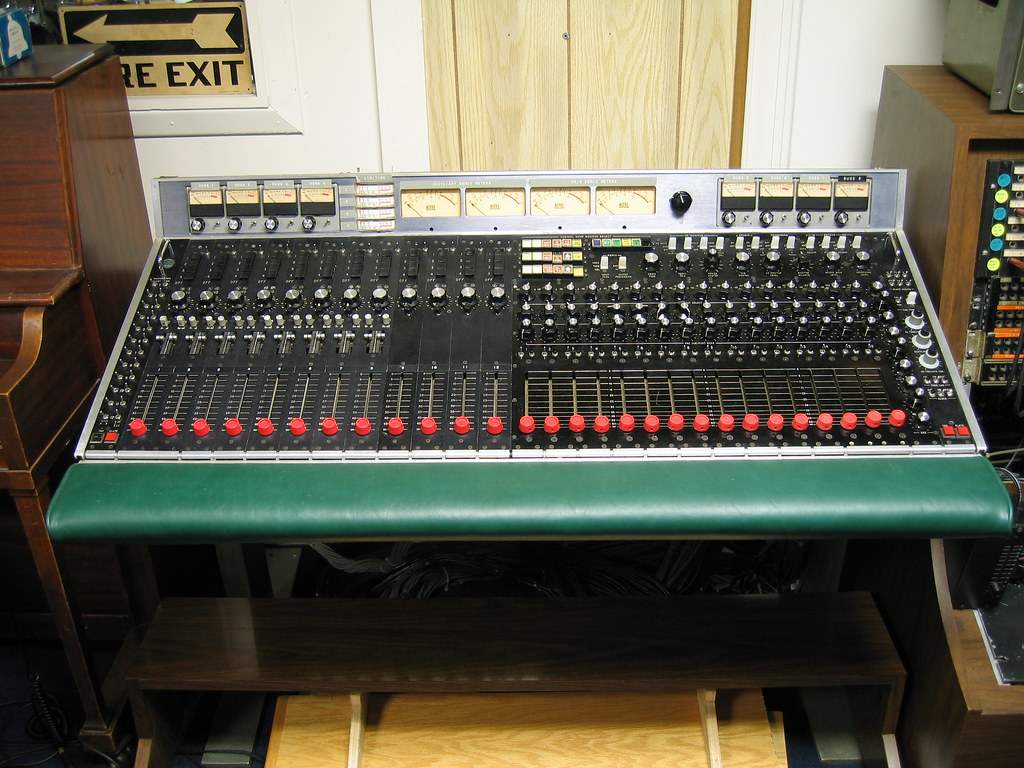
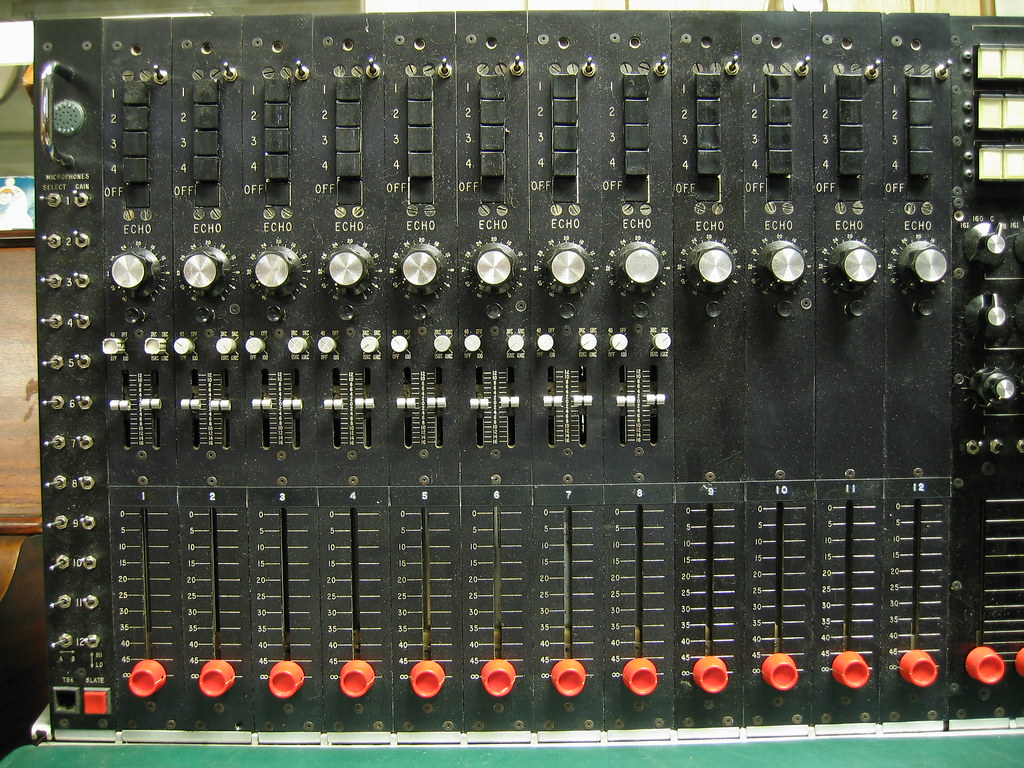
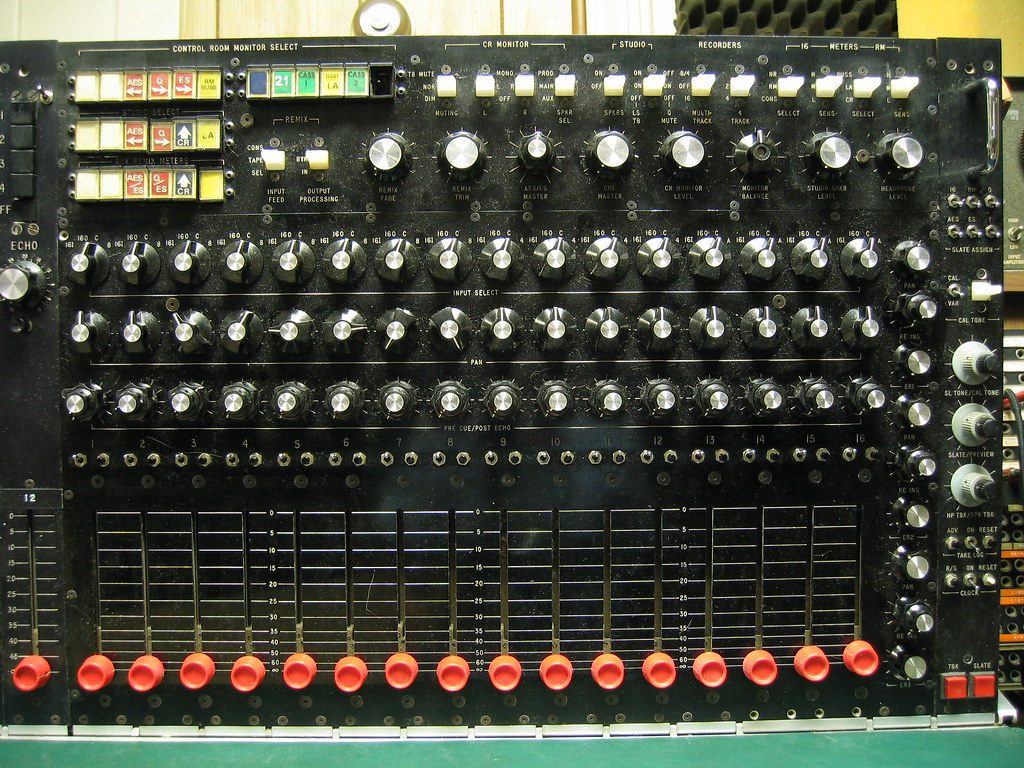
It started life as a 12 x 4 tracking console, containing Altec 9470A amps for input and buss driver amps, 8 channels with 9061A EQ's, all 12 channels having 600/600 ladder echo sends and 600/600 ladder faders. The 12 strips were originally centered in the frame with lots of blank panel space on either side. I assume this thing was considered partially obsolete the very moment the 8 track machine arrived. I was told they had a separate home-made rotary knob panel for mixdown before the rebuild.
Around 1975 the original section was restructured as a 12x8 with additional discrete buss amps, and a solo buss was added. A completely custom 16x2 remix section was added, along with a comprehensive master section. The remix section uses Langevin 600/600 ladder faders, has pre/post sends and pan, solo, mute, and 3 echo returns. It appears to feed output amps of a more dubious nature; early custom RCA IC amps with discrete output followers. The master section is fairly comprehensive. Almost forgot; the linear master fader is a stereo Langevin 600/600 ladder in a tethered outboard box that rests to the side on the furniture side-wing portion of the console. The furniture bits are not attached in the pics, but you can see the meter bridge top sitting on the floor beneath it in the first pic. The 1975 rebuild included a rotary master fader which was later disconnected in favor of the sidearm box.
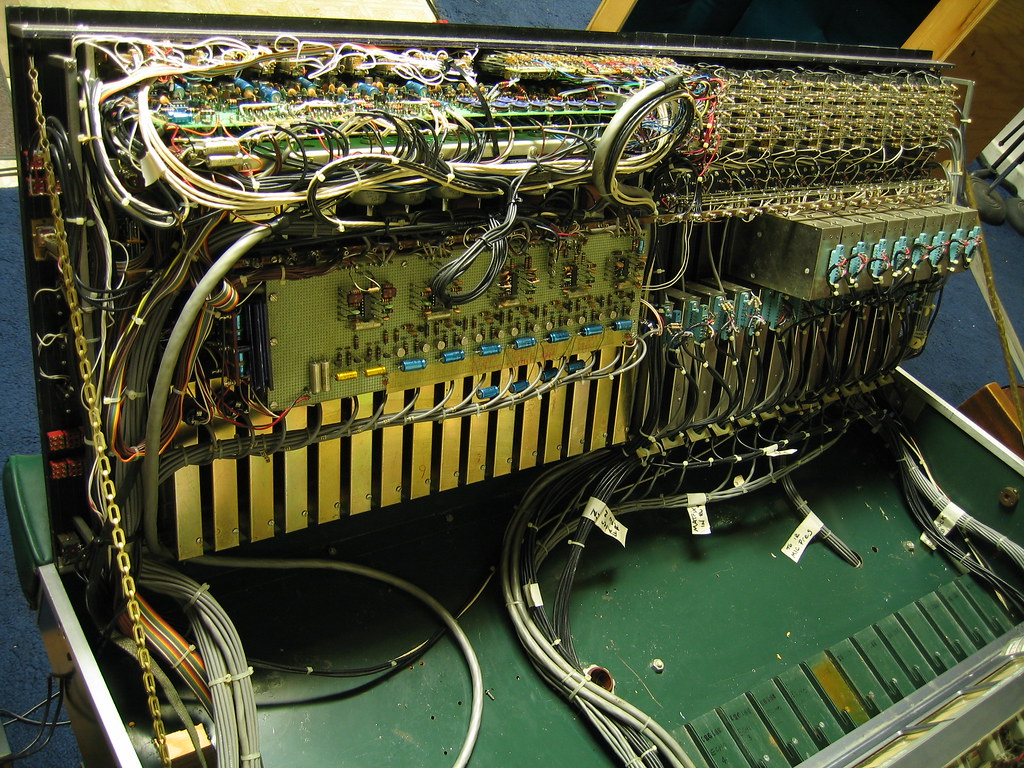
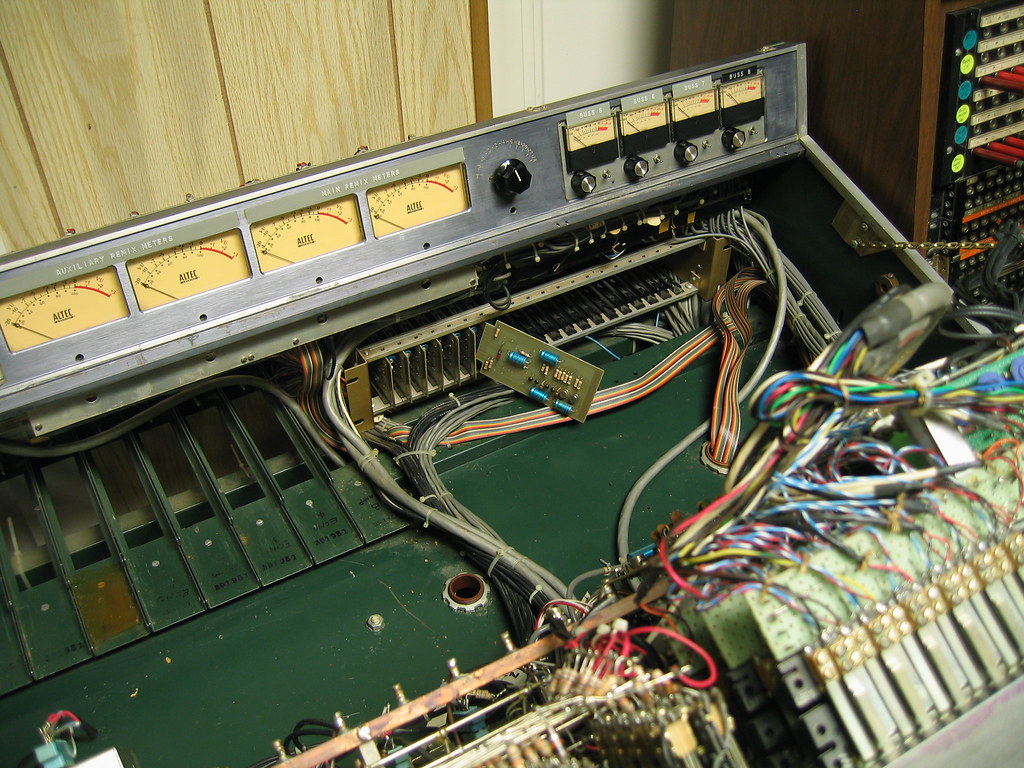
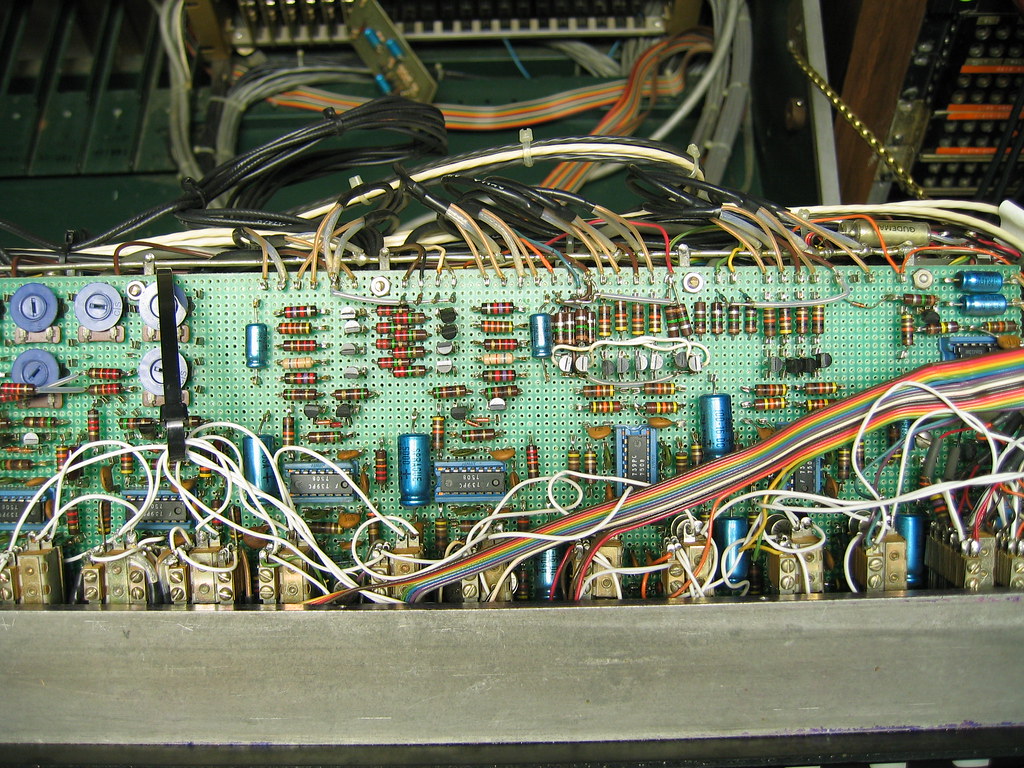
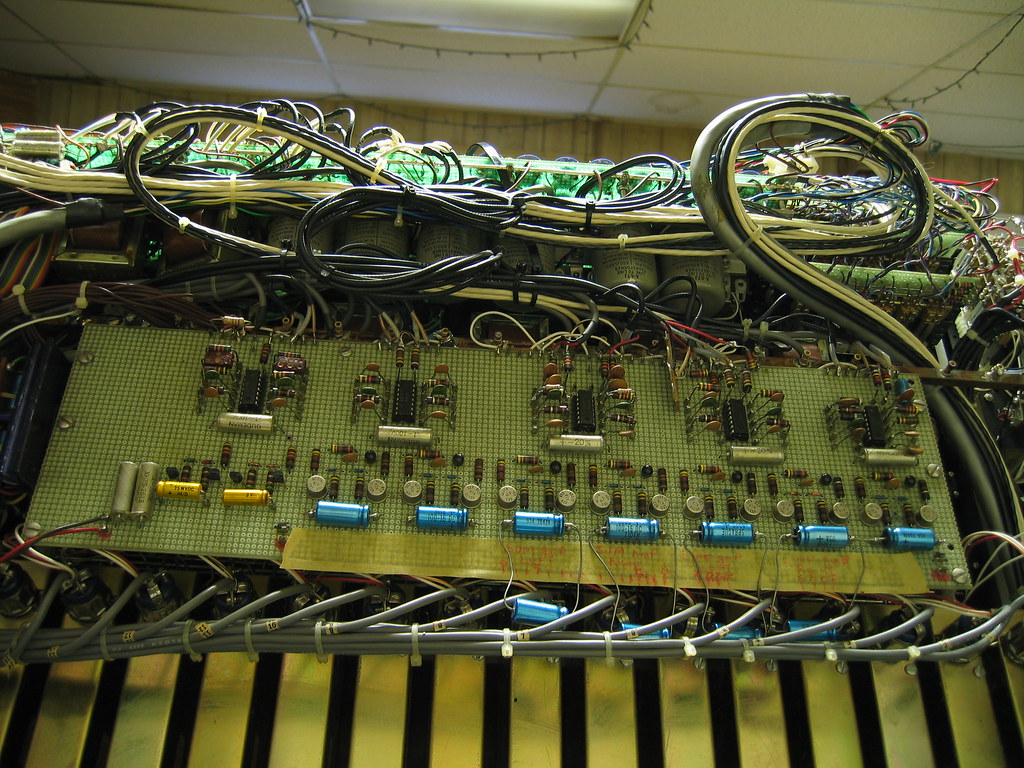
Of course, there is no documentation, so there's a lot to figure out. The original Altec section is fairly self explanatory, as will be the basics of the remix section, but the master section, meter driver, talkback, oscillator and logic portions will be a real mindtwister being entirely homemade on perf board.
I'll initially explore the realities of converting it to 28x2, with panning added to the 12 Altec channels. The 8 busses may or may not make sense, as it's mono busses off of the 12 tracking channels only, and multed to pairs on the patchbay for feeding a 16 track. I doubt I'd ever track with this thing given the number of stand-alone pres I already have. Probably just try to put it to use as a line level mixing device. There's plenty of room to change the output stage circuits entirely if need be. It's a very interesting blend of desirable and undesirable seeming sections.
It sounded quite nice and open on audition at the sellers studio. I haven't heard it with any of my own tapes.
I read every thread I could find about passive mixer design, and luckily have all the Audio Cyclopedia variants for reference. I recently reverse-engineered one of the extant tube Neve consoles which was modified to have panning at some point, and I've studied many of the antique 600 ohm constant impedance broadcast mixers, so hopefully I'm ready for this one. The amount of reverse-engineering and mod work is daunting; on the other hand I never imagined I'd find such a perfect test-bed with so much of the work already done. I can't imagine the build time that was put into this thing.
I found some Altec lit that shows one in use at Owen Bradley's Barn in Nashville, circa 1970. I've not turned up much other evidence of their use; several concert hall installations, an LA TV station, at least one unidentified recording studio in NY.
I was told part of a Cheech & Chong record was tracked on this one; good enough for me!
Subject at hand is a freshly acquired Altec 9200A console, circa 1968, highly modified and expanded by one John Frey in DC about 1975.



It started life as a 12 x 4 tracking console, containing Altec 9470A amps for input and buss driver amps, 8 channels with 9061A EQ's, all 12 channels having 600/600 ladder echo sends and 600/600 ladder faders. The 12 strips were originally centered in the frame with lots of blank panel space on either side. I assume this thing was considered partially obsolete the very moment the 8 track machine arrived. I was told they had a separate home-made rotary knob panel for mixdown before the rebuild.
Around 1975 the original section was restructured as a 12x8 with additional discrete buss amps, and a solo buss was added. A completely custom 16x2 remix section was added, along with a comprehensive master section. The remix section uses Langevin 600/600 ladder faders, has pre/post sends and pan, solo, mute, and 3 echo returns. It appears to feed output amps of a more dubious nature; early custom RCA IC amps with discrete output followers. The master section is fairly comprehensive. Almost forgot; the linear master fader is a stereo Langevin 600/600 ladder in a tethered outboard box that rests to the side on the furniture side-wing portion of the console. The furniture bits are not attached in the pics, but you can see the meter bridge top sitting on the floor beneath it in the first pic. The 1975 rebuild included a rotary master fader which was later disconnected in favor of the sidearm box.




Of course, there is no documentation, so there's a lot to figure out. The original Altec section is fairly self explanatory, as will be the basics of the remix section, but the master section, meter driver, talkback, oscillator and logic portions will be a real mindtwister being entirely homemade on perf board.
I'll initially explore the realities of converting it to 28x2, with panning added to the 12 Altec channels. The 8 busses may or may not make sense, as it's mono busses off of the 12 tracking channels only, and multed to pairs on the patchbay for feeding a 16 track. I doubt I'd ever track with this thing given the number of stand-alone pres I already have. Probably just try to put it to use as a line level mixing device. There's plenty of room to change the output stage circuits entirely if need be. It's a very interesting blend of desirable and undesirable seeming sections.
It sounded quite nice and open on audition at the sellers studio. I haven't heard it with any of my own tapes.
I read every thread I could find about passive mixer design, and luckily have all the Audio Cyclopedia variants for reference. I recently reverse-engineered one of the extant tube Neve consoles which was modified to have panning at some point, and I've studied many of the antique 600 ohm constant impedance broadcast mixers, so hopefully I'm ready for this one. The amount of reverse-engineering and mod work is daunting; on the other hand I never imagined I'd find such a perfect test-bed with so much of the work already done. I can't imagine the build time that was put into this thing.
I found some Altec lit that shows one in use at Owen Bradley's Barn in Nashville, circa 1970. I've not turned up much other evidence of their use; several concert hall installations, an LA TV station, at least one unidentified recording studio in NY.
I was told part of a Cheech & Chong record was tracked on this one; good enough for me!













![Electronics Soldering Iron Kit, [Upgraded] Soldering Iron 110V 90W LCD Digital Portable Soldering Kit 180-480℃(356-896℉), Welding Tool with ON/OFF Switch, Auto-sleep, Thermostatic Design](https://m.media-amazon.com/images/I/41gRDnlyfJS._SL500_.jpg)



















